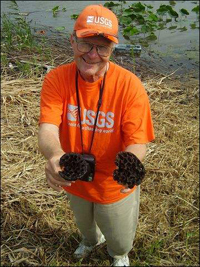Human Flower Project
Thursday, October 18, 2007
American Lotus: Taking Sides on a Michigan Symbol
In Southeastern Michigan, landowners and conservationists spar over eradication of a plant on the state’s threatened species list. And not just any plant—but a symbol.
 Dr. Bruce Manney with lotus husks near Plum Creek, Michigan
Dr. Bruce Manney with lotus husks near Plum Creek, Michigan
Photo: Charles Slat, for Monroe Co. News
Why is this man smiling? Because he’s found seed pods of the American Lotus, a species that’s been on Michigan’s list of “threatened” plants for years. The plant is now making quite a comeback, to the delight of most Michigan naturalists and the chagrin of some shoreline landowners.
Dr. Bruce Manney works with the U.S. Geological Survey’s Great Lakes Science Center in Ann Arbor. A few months back, at the height of lotus blooming season, he toured the Monroe County Lotus Garden Club through several watery stretches of Southeastern Michigan and delivered boatloads of good news: not only is the American Lotus (Nelumbo lutea Willd) growing well, but “whitefish have been found spawning again in the lower half of the Detroit River for the first time in 90 years.” According to Dr. Manney, “The Detroit River has got to be a lot cleaner than it’s ever been in a long time for those whitefish eggs to survive on the bottom of the river from November to March.” He added that some wildlife researchers had even seen baby sturgeon in the river, too, and mayflies, which the sturgeon eat.
 American lotus spread through Eagle Island Marsh, near the Automotive Components Plant outside Detroit
American lotus spread through Eagle Island Marsh, near the Automotive Components Plant outside Detroit
Photo: River Raisin Area of Concern
The Lotus Garden Club began its annual tours in 1992, after some of the future-members spotted the gorgeous water plants from the air growing near power stations on Lake Erie. They gained permission to seed more lotuses in the area. What it is about lotuses and factories? We found that two years ago the U.S. Fish and Wildlife Service partnered with Automotive Components Holdings, LLC, to turn 240 acres behind the company’s plant into a coastal wetlands, now called Eagle Island Marsh. The American Lotus appears to have taken off there as well.
Meanwhile, closer to Detroit, folks aren’t so happy with the lotus’s roaring comeback. Tina Lam of the Detroit Free Press interviewed residents of Hickory Island who want the plant cleared from Gibraltar Bay. They say that a once-small patch of lotus has been egged on by conservationists who’ve seeded the edges of the natural growth—so that now a floating lotus garden extends across 10 acres, choking the waterway and making it impassable for their boats. Since Amercian lotus is on the state’s list of threatened species, removing it can bring a fine of up to $500; but if indeed these lotuses were sown, they wouldn’t qualify for protection.
The very same plant, in fact, is considered a ”noxious weed” in Connecticut. And we came across this interesting message from Chuck Surprenant, now retired from the U.S. Fish and Wildlife Service. Michiganers leery of the lotus have cause for concern, he writes. “Experience here in southern Illinois on Crab Orchard Lake (7,000 acres) has shown the plant to be mysterious in its ability to dominate one portion of the lake for years, then inexplicably decline and appear in another part of the lake. For 20 years, American Lotus dominated Grassy Bay, in the south central part of the lake; then it mysteriously died off. Currently, the plant is spreading rapidly in the upper location of the lake, growing from a small 1-acre patch to at least 1,000 acres in just a few years.” That sounds less like “threatened,” more like “threatening.”
 American Lotus
American Lotus
(Nelumbo lutea Willd)
Photo: Susan R. Crispin
We find the push and pull, the “noxious” v. “threatened” debate over the American lotus fascinating. It’s a showy example of how even the most rigorous science can sometimes be swayed by the powerfully symbolic force of flowers (a sway-ableness we consider admirable and wise, by the way). For in Michigan, Nelumbo lutea Willd is not just another plant whose numbers decline and increase. The native lotus is, as Tina Lam writes, “the state’s official symbol of clean water.” The president of Monroe County’s Lotus Garden Club, Jeanne Micka, stressed, “They’re like the canary in the cave. If you see a lot of them, it means your water quality is pretty good….If they disappear, you’d better look out.”
Micka added (in keeping with the “mystery” Chuck Surprenant described) that lotus seeds can remain viable for as much as a century. Oh, Jeanne, symbols tend to be “viable” a whole lot longer even than that.

